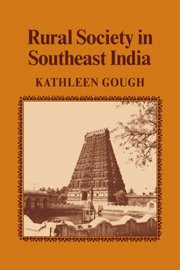Book contents
20 - Economy and Class Structure
from Part III - Kirippūr
Published online by Cambridge University Press: 29 October 2009
Summary
The Annual Round
The agricultural year in Kirippūr resembled that in Kumbapeṭṭai except that almost all operations occurred two to three weeks later because of the later arrival of the water, usually in late Ani or early Adi (early to mid-July). As in Kumbapeṭṭai, shepherds from Rāmanāthapuram grazed their sheep in the paddy fields in mid-April to mid-June.
The greatest difference from Kumbapeṭṭai was that only about 10 percent of the wet land grew two crops a year. On most of their land, the majority of farmers grew only a single sambā crop, which was sown in Āvaṉi and reaped in Thai or Masi (see Table 11.1 for the seasons in Kumbapeṭṭai). A few farmers whose land lay on higher ground might grow a single kuruvai crop and dispense with sambā on at least part of their land. Those who grew two crops a year normally sowed and transplanted both sets of seeds together in Āḍi. The kuruvai crop, of short duration, was harvested in late Aippasi (early November). Long stalks were left in the field, so that the second crop, called oṭṭadan, could continue to grow and be harvested in Masi. Separately sown kuruvai and sambā crops could not be grown in Kirippūr, for the kuruvai harvest came late and there was no time to replough the land before the sambā transplanting. On the other hand, Kumbapeṭṭai did not grow oṭṭadan because the crop required much water, which was available during the heavier, coastal rains of October and November in east Thanjāvūr.
- Type
- Chapter
- Information
- Rural Society in Southeast India , pp. 367 - 388Publisher: Cambridge University PressPrint publication year: 1982



